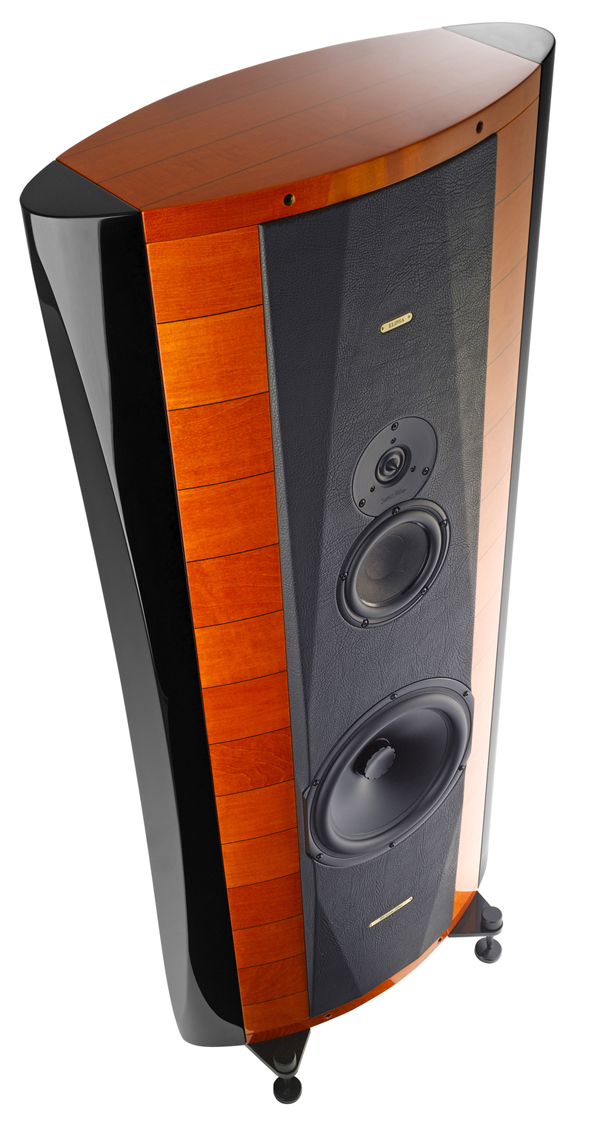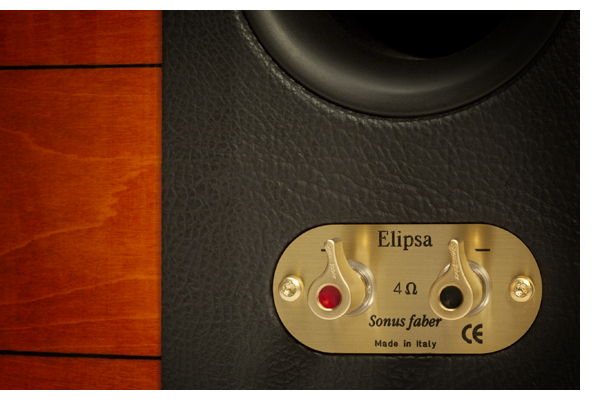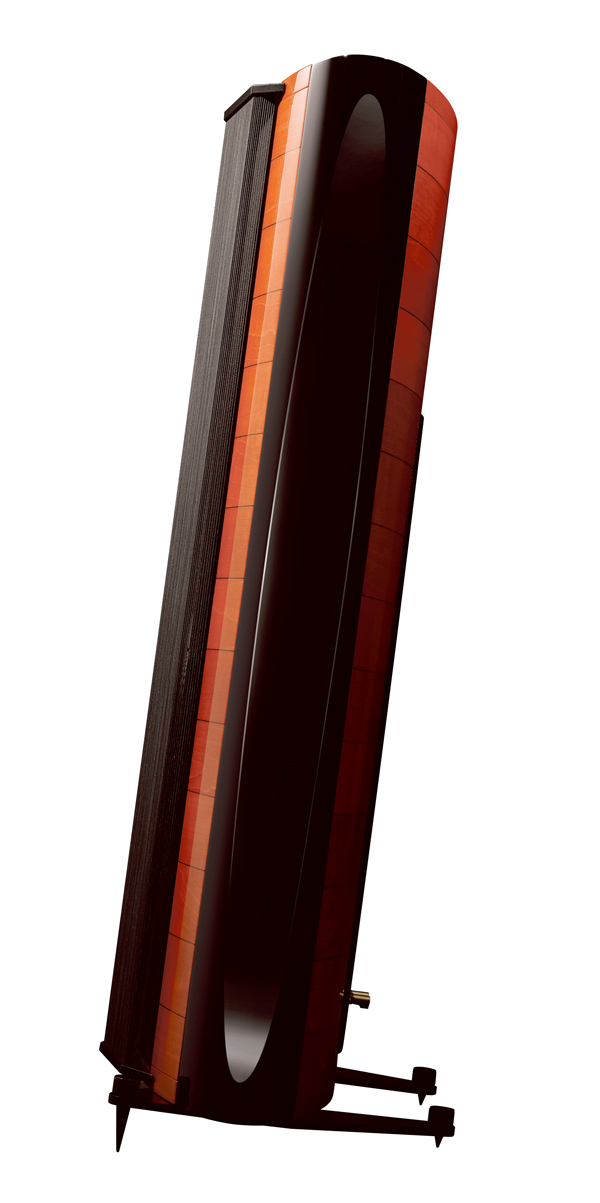Sonus Faber Elipsa SE Stunning in Every Way
By Jeff Dorgay There is nothing better than having your cake and eating it too. Few speakers personify this idiom like those from Sonus faber—they are stunning, even when your system is off. And the minute the speakers deliver music, whether analog or digital, you are immediately transported to a place where you can forget about the gear, your troubles and whatever else comes to mind, and immerse yourself in the music.
There is nothing better than having your cake and eating it too. Few speakers personify this idiom like those from Sonus faber—they are stunning, even when your system is off. And the minute the speakers deliver music, whether analog or digital, you are immediately transported to a place where you can forget about the gear, your troubles and whatever else comes to mind, and immerse yourself in the music.
First, full disclosure: This reviewer is biased. While many of us claim to want a “straight wire with gain,” or “the whole truth, warts and all,” I can’t honestly say I subscribe to either of these philosophies 100% of the time. Maybe I could if all music was perfectly captured and flawlessly recorded—but we all know it’s not. Being a lover of panel speakers, electrostats in particular (and a closet lover of SET/single-driver systems), I value coherence most of all. I don’t give a damn how dynamic a speaker is. If it sounds like the music is coming from a separate woofer, tweeter and midrange, the speaker falls down my list rather quickly.
A warm, syrupy and ultimately colored speaker doesn’t do it for me either. Such an overly romantic-sounding speaker is as equally boring to me as a hyperdynamic, ruthlessly revealing speaker. Sure, both make for exciting demo sessions, but they always end up being less entertaining after you’ve lived with said speakers for an extended period of time.
The speakers that always hold my long-term interest are those rare few that achieve a balance of high resolution without being harsh, and a high degree of tonal richness without coming across overly colored or slow. Those of you old enough to remember taking pictures with a film camera might remember the 81A filter, which offered a slight touch of warmth yet was never distracting, and had the ability to make color slides look richer and more vibrant than reality. Speakers that top my list must sound great regardless of decibel output and, while we’re making demands, they should not rely entirely on cables and amplifiers to achieve greatness. They must also be relatively simple to set up. How’s that for fussy?
Enter the Elipsa SEs
I’ve always been a fan of Sonus faber’s speakers, even though the Italian manufacturer’s older models have always been slightly romantic and forgiving. But things at Sonus faber have been quietly changing as of late, and its current models retain the mystique of their predecessors while adding an abundance of resolution to the mix.
If you’ve been envious of the $45,000/pair Sonus faber Stradivari speakers but can’t make the financial leap, the Elipsa SE is a bargain at $22,900/pair. For all but the top percentile of the truly obsessed, this is the last pair of speakers you need to buy. The SE model offers an upgraded crossover over the standard Elipsa, and incorporates the same tweeter from the Stradivari—a modest yet worthwhile upgrade from the $20,000/pair Elipsa.
We can discuss crossover slopes, sensitivity and driver-magnet structures all day and, while that is a fascinating story to tell, when you unpack the Elipsa SEs, it’s a sensual experience; not a scientific one. The true aficionado will appreciate the painstaking effort that goes into every step of the Elipsa SE’s construction. Whether admiring the hand-coated lacquer of the finish, the leather front and rear baffles or even the finely machined binding posts, you quickly realize that there are no “off-the-shelf” parts used in a Sonus faber speaker.
As anxious as you will probably be to get your new speakers up and running, take a few minutes to bask in the unrivaled craftsmanship that went into their construction.
Cueing up Chicago’s “While the City Sleeps” from Chicago V (via the 24/192 HDtracks file) immediately shows off the refined high end of the Elipsa SEs, as the high hat shimmers slightly to the left of the sound stage with seemingly endless decay. The instant the horns enter the mix with full force it’s clear that these speakers have dynamics to spare. Giving the volume control a major push to the right—reaching near-insane levels—the Elipsa SEs do not lose their composure: The enormous three-dimensional sound stage remains large and focused.
Slowing the pace somewhat with the title track of Herbie Hancock’s Maiden Voyage (also available as a 24/192 download from HDtracks) portrays an even larger soundstage—now the Elipsa SEs completely disappear in the room, as the drums linger to the left of centerstage, with Freddie Hubbard blasting out on trumpet at the far left, and Hancock’s piano diffusely rendered as it moves gently up and back from center stage.
Combined with a full compliment of Audio Research’s Reference electronics and a dCS Paganini stack, one wonders if the presentation could be any better. This is what real music sounds like. While much of this impact can be attributed to the first-order crossover network and wideband drivers required to successfully implement this kind of design—a result of exhausting driver development to achieve perfection—that is only part of the story. It is the integration of everything that makes a Sonus faber speaker system truly more than just a sum of the individual parts.
Sonus Faber’s elliptic enclosure design results in what they call “Virtual 2pi radiation,” which also does a fantastic job disguising the mass of the speaker in such a svelte cabinet, resulting in a high performance speaker that is easy to set up in your room.
Even casual placement results in a wide and deep soundstage. However, a bit of extra attention to the rake angle of the Elipsas allows them to achieve their maximum performance when set to perfection. The resulting time alignment of the drivers adds to the coherence and the speakers literally disappear in the room. A calibrated level (or iPhone app) will help you get both speakers tipped back exactly the same amount.
A great many speaker manufacturers strive to make their speaker enclosures as free from resonance as possible, but it almost always ends up making the speaker sound overdamped. Listen to the sound a bass drum makes as the mallet bounces from the drumhead: There’s a liveliness to it, with resonance and sustain, regardless of whether it’s Tommy Aldridge or Art Blakey playing. That’s the life force of a bass drum, which is, sadly, often lost in a speaker (or, for that matter, an entire system) that is overdamped.
An instrument’s resonant signature is much like a person’s voiceprint: Each one is unique, which allows us to discern the difference between violins or electric guitars. The Elipsa SE preserves this delicate balance. Yet, even with music created entirely in the world of the studio, the Elipsa SE holds it together seamlessly, no matter how complex the fare. A long listening session of albums from Frank Zappa and German bands Can and Faust proves that, even at high volume, the speakers can play densely packed music without a soundstage collapse. Faust’s “Picnic on a Frozen River” from the Faust IV album is full of multiple soft, discordant bits that remain anchored in the left-to-right as well as in the front-to-back soundstage at high volume. Zappa’s classic “Peaches En Regalia” offers a similarly exciting experience, with synthesizer riffs flying around my listening chair, just as it does when listening through great headphones.
Moving into the 21st century, Playing Daft Punk’s Tron: Legacy Reconfigured reveals no weaknesses in the Elipsa SE, nor any sign of fatigue. Even though this speaker has a low frequency specification of 35 Hz, they are well up to task of hitting this album’s the deep bass grooves. And the high sensitivity of these speakers will not tax your amplifier, which adds to the dynamic realism that they offer.
The Elipsa SEs perform equally well at low volume, still easily disappearing into the room like mini-monitors. Beethoven’s Symphony No. 7 performed by the Netherlands Wind Ensemble shows the delicacy that these speakers are capable of, as well as the tonal purity.
Very Amplifier-Friendly
With a wide range of amplifiers at my disposal—solid-state, tube and class D amps, ranging from a pair of 20-watt 845 SET monoblocks all the way up to the mighty Pass Labs’ XA200.5 monoblocks—all were able to drive the Elipsa SEs without difficulty. Granted, each amplifier imposed its own sonic personality on the presentation, which complements the high resolution that these speakers offer. But still, every variation on the theme remained thoroughly enjoyable.
Thanks to a sensitivity of 91 db per watt, the Elipsa SE is comfortable with the 35 watts per channel that the average EL34-based tube amplifier can provide, but because the speakers have a maximum power handling of 300 watts, they will absolutely crank if you have enough high-quality power on tap.
Driven to ear-shredding levels (by the XA200.5 monoblocks) with Mudhoney’s Superfuzz Bigmuff, the speakers revealed their true gloriousness. The only distortion present was that of the amplifiers in the recording studio. Following this up with the Pixies’ Tromp Le Monde and ending with Explosions in the Sky’s The Earth is Not a Cold, Dead Place is perhaps a bit off the path of the lute that Sonus faber mentions on their website, but it leads to the most important aspect of these speakers: They are unflappable.
After giving the Elipsa SEs a major workout with about 15 different amplifiers of all genres, I must confess two things: There was no combination that turned in a bad performance and, being the hopeless romantic that I am, I was seduced completely when combining these speakers with a few of my favorite tube amplifiers.
Now that Audio Research is part of the Fine Sounds corporate umbrella that owns Sonus faber, it is no surprise that the Audio Research Reference electronics are a fantastic match for these speakers. Yet, whether I was using the PrimaLuna DiaLogue 7 monoblocks, the Octave Jubilee Mono monoblocks or the Balanced Audio Technology VK-150s monoblocks, it was tough to get any work done while listening to these speakers. The massive soundstage and dreamy midrange sent me back to the record rack repeatedly and many listening sessions ended in the wee hours.
But is the Elipsa SE Right for You?
That’s the answer to the $22,900 question, of course. This is a pretty tall stack of twenty-dollar bills to spend on a pair of speakers, but few others exist at this price point that approach the Elipsa SE’s level of performance. And even fewer exist that are this gorgeous. But I am of the belief that life’s too short to have ugly speakers in your living room. As it turns out, I am not alone. In an informal poll, the Elipsa SEs have the highest spousal-acceptance factor of any speaker we’ve ever reviewed, as well as the highest interest among non-audiophiles of either gender.
If you want a perfect fusion of acoustic purity and aesthetic beauty, these are the speakers you’ve been waiting for. The truly tough decision will be whether to acquire the Elipsa SEs or go all the way to the Strads.
Many audio pundits cling to the philosophy that the source is everything in a system, and that is sound advice. However, I find the speakers to be the biggest variable in a system—they have to integrate with your room and those you share it with, so they are often the highest hurdle to jump. These speakers are so easy to drive, you would have little trouble starting your journey with modestly priced amplification and avail yourself to a new experience as your budget permits system upgrades.
About 15% smaller in physical dimension and with only one 10-inch woofer (rather than the two in the Strads), the Elipsa SE lends itself more to the average listening room. As Sumiko VP of Sales Norbert Schmeid mentions, “While the Stradavari is ultimately capable of more performance, the Elipsa is an easier speaker to set up because of the single woofer.” And, at about 100 pounds each, you can move them around your listening room with relatively minimal effort.
Either way, you’ll get your money’s worth—and then some. Don’t be surprised to see these speakers in our awards issue later this year.
The Sonus Faber Elipsa SE
MSRP: $22,900/pair
www.sonusfaber.com (Factory)
www.sumikoaudio.net (US distributor)
Peripherals
| Digital Source | dCS Paganini Sooloos Control 15 Aurender S10 |
| Analog Source | AVID Acutus Reference SE/SME V/Lyra Atlas |
| Preamplifier | ARC REF 5SE Burmester 011 Robert Koda K-10 |
| Amplifier | ARC REF 150 Burmester 911 Pass Labs XA200.5 |
| Phonostage | ARC REF Phono 2SE |
| Cable | Cardas Clear AudioQuest Sky |





